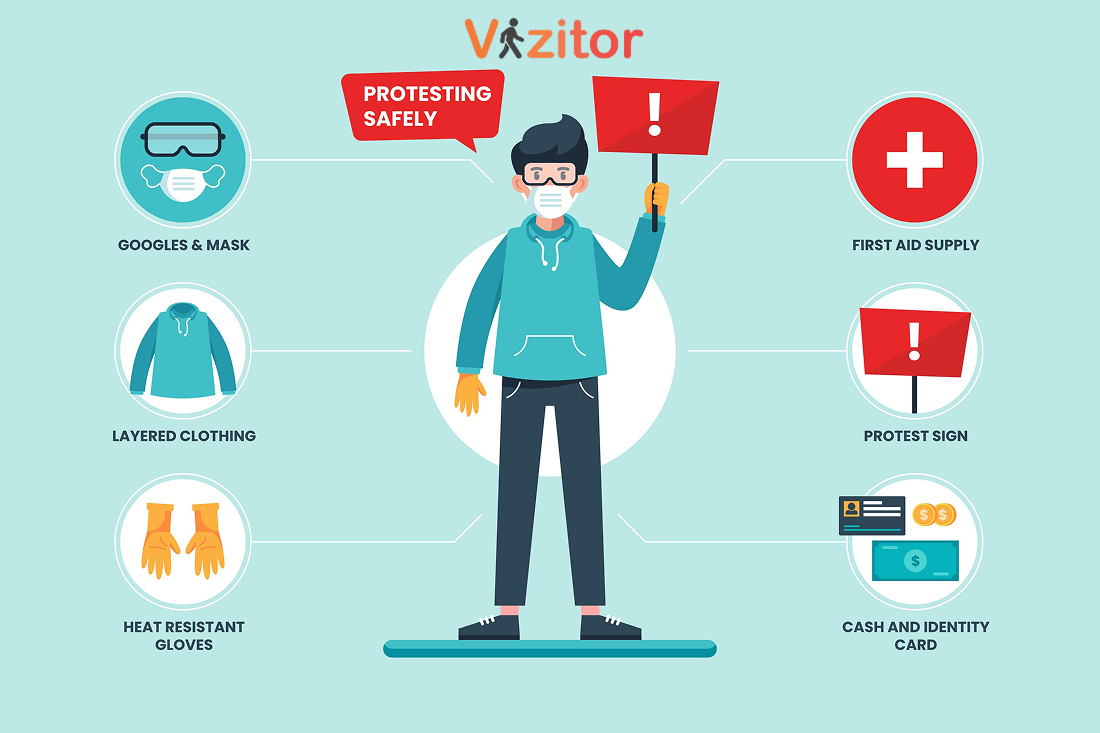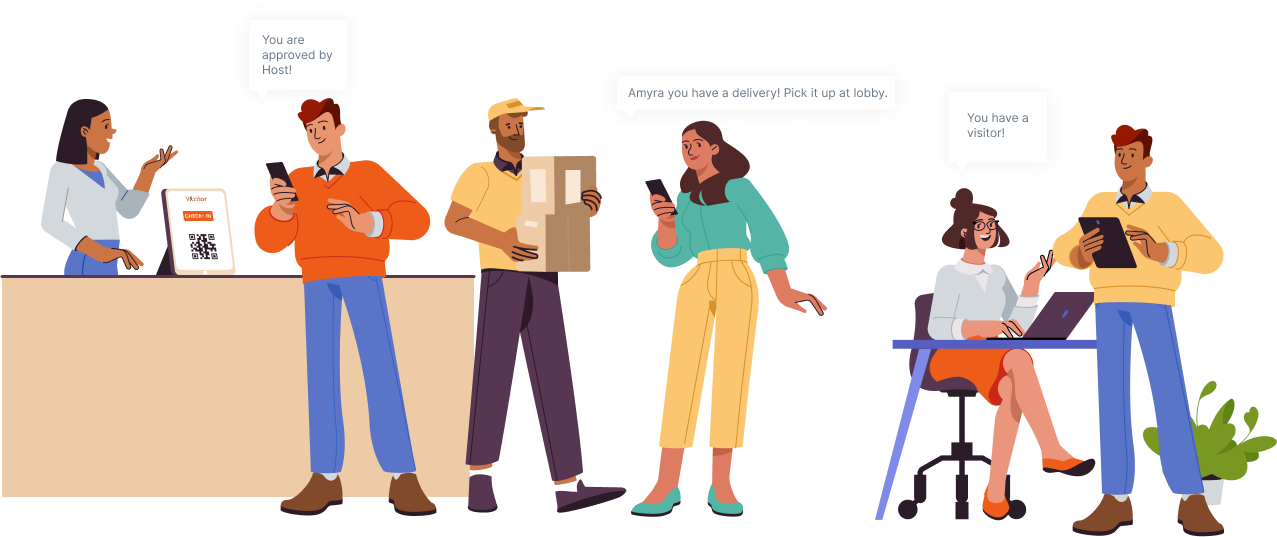Table of Content
Try Vizitor for Free!

Fri, Feb 14, 2025
Read in 8 minutes
Is Your Healthcare Facility Truly Safe?
Hospitals and healthcare centers are meant to be places of healing, but have you ever considered how safe they actually are for the people working inside them?
In the demanding environment of healthcare, the safety and well-being of both patients and staff are paramount. However, healthcare professionals face a significantly higher risk of workplace violence, with incidents occurring at a rate five times higher than in other industries.
From unauthorized visitors wandering into restricted areas to violent outbursts in emergency rooms, the risks are real and growing. And it’s not just external threats—poor compliance with safety regulations can lead to legal consequences, data breaches, and operational shutdowns.
So, how can healthcare facilities ensure the safety of their staff, patients, and visitors?
The key lies in proactive security measures, a robust visitor management system, and strict compliance protocols.
In Melbourne, public hospitals reported over 680 “code black” incidents—situations involving violent or armed threats—in a single financial year, averaging one every 12.8 hours.
These alarming statistics underscore the urgent need for comprehensive safety and compliance strategies in healthcare settings.
What steps can be taken to address these challenges?
By implementing targeted measures, facilities can create a secure environment that safeguards both employees and patients.
In this guide, we’ll explore seven essential strategies that every healthcare facility must implement to create a secure health environment.
1. Strengthening Visitor Management Policies at Hospital Premises
How can healthcare facilities effectively monitor and control visitor access?
Hospitals and clinics experience high foot traffic daily, making them vulnerable to unauthorized access, theft, and even violence. A visitor management system (VMS) for hospitals is essential for monitoring who enters and exits the facility.
Effective visitor management is crucial in preventing unauthorized access and ensuring a secure environment.
Some Amazing common practices to enhance Visitor Management System at hospitals and clinics:
Implement the following measures to ensure patient and employee safety at hospitals and healthcare facilities.
Visitor Identification Badges: Issue badges displaying the visitor’s photo, name, and authorized areas. This practice helps staff and patients easily identify authorized individuals.
Time-Limited Access: Utilize badges that expire after a set period to prevent re-entry without proper authorization.
Digital Check-In Systems: Employ electronic kiosks or mobile applications for efficient visitor registration and tracking.
Case study: Unauthorized Entry Prevention
In a 2022 incident, a hospital in New York discovered that unauthorized persons had been accessing patient records due to a lack of proper visitor tracking.
After implementing a secure VMS, they significantly reduced unauthorized access and enhanced patient privacy.
2. Provide Comprehensive Staff Training
What training programs are essential for preparing staff to handle potential threats?
Regular training equips staff with the skills to handle potential threats and maintain a safe workplace. Training programs should cover:
De-escalation Techniques: Teach methods to calm agitated individuals and defuse potentially violent situations.
Emergency Response Protocols: Ensure staff are familiar with procedures for various emergencies, including active shooter scenarios, fires, or natural disasters.
Cultural Competency and Sensitivity: Promote understanding and respect for diverse backgrounds to reduce misunderstandings and conflicts.
According to studies,
A comprehensive survey conducted among 1,566 healthcare workers across India revealed that over 58% feel unsafe in their workplace, with 78.4% reporting threats while on duty
3.Strengthen Cybersecurity & Patient Data Protection
With the rise of digital healthcare records, data breaches have become a growing concern. In 2023, the U.S. healthcare industry experienced over 500 data breaches, exposing millions of patient records.
Case Study: Cyber Attack on a Major Hospital
A ransomware attack on a leading healthcare provider paralyzed hospital operations for a week, delaying surgeries and patient care. The hospital paid $1.5 million in ransom and spent months recovering from the breach.
Ways to Strengthen Cybersecurity in healthcare facilities:
- Implement multi-factor authentication (MFA) for access control.
- Encrypt all patient data and restrict unauthorized access.
- Conduct regular cybersecurity training for staff.
- Have a disaster recovery plan for data breaches
According to reports,81.3% of healthcare professionals have witnessed violence in their workplace, yet nearly half (44.1%) believe these incidents are inadequately addressed.
4. Promote Open and Clear Communication
Fostering a culture of open communication in healthcare is essential for enhancing workplace safety and ensuring compliance.
When team members feel comfortable sharing concerns, reporting incidents, and discussing potential risks without fear of retribution, it leads to proactive identification and mitigation of issues.
Integrating real-time visitor notifications into healthcare facilities is a crucial step in enhancing workplace safety and fostering a culture of open communication.
By implementing advanced visitor management systems, healthcare organizations can monitor and manage visitor access effectively, ensuring that staff are promptly informed of any arrivals or potential security concerns.
Benefits of Integrating Real-Time Visitor Notifications:
Immediate Awareness: Staff receive instant alerts when visitors check in, allowing them to prepare accordingly and address any potential issues proactively.
Enhanced Security: Real-time notifications help in identifying unauthorized visitors quickly, reducing the risk of security breaches.
Improved Coordination: Timely information about visitor movements facilitates better coordination among healthcare teams, ensuring that patient care is not disrupted.
Provide Training in Communication Skills: Equip staff with the tools to effectively convey concerns and listen to others, fostering mutual respect and understanding.
5. Implement Robust Security Measures at hospital premises
What security enhancements can deter potential threats in healthcare settings?
Physical and technological security enhancements deter potential threats and protect both staff and patients. Consider the following:
Alarm Systems: Install panic buttons or mobile alarm applications that allow staff to discreetly summon help during emergencies.
Surveillance Cameras: Place cameras in strategic locations to monitor activities and deter misconduct.
Controlled Access Points: Restrict entry to sensitive areas using key cards or biometric systems.
6. Establish a Well-Defined Emergency Preparedness Plan
Natural disasters, fires, or violent incidents can disrupt healthcare services. Hospitals must be prepared for emergencies to ensure patient and staff safety.
Essential Emergency Preparedness Plans for healthcare services:
- Conduct fire drills and evacuation simulations.
- Have a backup power supply for critical medical equipment.
- Train staff on active shooter response and lockdown procedures.
- Maintain emergency contact lists and first aid kits at all locations.
7. Implement Attendance Management Systems for Staff
Accurate tracking of employee attendance is crucial for operational efficiency and compliance with labor regulations.
Automated Timekeeping: Utilize digital systems to record staff check-ins and check-outs, reducing errors associated with manual processes.
Compliance Monitoring: Ensure adherence to working hour regulations and promptly identify patterns that may indicate burnout or understaffing.
Also explore: The Ultimate Guide to Queue Management system in Hospitals
8. Utilize Time-Expiring Visitor Badges
Hospitals should issue visitor badges that include names, photos, and expiration times to prevent unauthorized re-entry.
Why Are Time-Expiring Badges Essential?
Prevents Badge Misuse: These badges change color after a set time, making them useless for unauthorized re-entry.
Enhances Security: Only active badges allow access, reducing impersonation risks.
Supports Emergency Evacuations: In case of an emergency, security staff can quickly identify visitors and ensure their safe exit.
Enhance Workplace Security with Vizitor’s Visitor & Workplace Management System for Hospitals
In healthcare facilities, ensuring workplace safety and security is not just a priority but a necessity. Unauthorized access, data breaches, and inefficient visitor tracking can lead to compliance violations, security threats, and operational inefficiencies.
This is where Vizitor’s Visitor Management System (VMS) and Workplace Security Solutions come into play, offering a smart, automated, and highly secure approach to managing visitors, staff, and overall workplace security.
How Vizitor Enhances Security & Compliance in Healthcare
1. Digital Visitor Check-In & Pre-Registration
🔹 Say goodbye to outdated manual logbooks—Vizitor provides a contactless, digital check-in system for patients, visitors, and vendors.
🔹 Pre-appointment scheduling allows hospitals to screen visitors before they arrive, ensuring compliance with safety protocols.
2. Real-Time Visitor Monitoring & Instant Alerts
🔹 Live visitor tracking provides real-time insights into who is inside the facility and their movement within restricted zones.
🔹 Instant security alerts notify administrators if unauthorized access is attempted, enhancing workplace security.
3. Automated Visitor Badge System
🔹 Generate unique, time-sensitive visitor badges with QR codes, photos, and access levels to prevent unauthorized access.
🔹 Temporary access restrictions ensure visitors do not enter sensitive areas like ICUs, pharmacies, or patient wards without proper clearance.
4. Secure Access Control & Compliance Management
🔹 Seamlessly integrate Vizitor with biometric access systems to restrict entry to authorized personnel only.
🔹 Ensures regulatory compliance with HIPAA, OSHA, and GDPR, keeping visitor records secure and audit-ready.
5. Emergency Evacuation & Safety Alerts
🔹 In case of a fire, security breach, or medical emergency, Vizitor instantly notifies all registered staff, security personnel, and visitors via real-time alerts.
🔹 Generate an evacuation report with a list of all present individuals, ensuring quick and effective crisis management.
6. Detailed Visitor Analytics & Reporting
🔹 Get real-time insights into visitor behavior, peak hours, and access trends.
🔹 Generate custom security reports for compliance audits and risk assessments.
Conclusion: Prioritizing Security & Compliance in Healthcare
Workplace safety and compliance in healthcare is not just about physical security; it also includes visitor management, staff attendance tracking, real-time alerts, and cybersecurity.
By implementing above seven essential strategies, hospitals can:
✓Reduce security risks
✓ Improve patient safety
✓ Ensure compliance with healthcare regulations
If your healthcare facility lacks a modern visitor management system or real-time security alerts, it may be at serious risk.
Take action today! Implement a Vizitor’s Visitor Management System (VMS) to enhance workplace safety and compliance.
Upgrade your hospital security today with Vizitor!
Learn more about Vizitor and contact us today!









